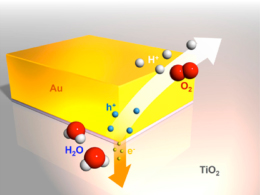可視・近赤外光によるプラズモン光電変換および水の光酸化
Plasmon-enhanced photocurrent generation and water oxidation from visible to near-infrared wavelengths
2013年9月6日 NPG Asia Materials 5, e9 (2013) doi:10.1038/am.2013.42
光エネルギー変換:長波長光を利用する

太陽光は有望な再生可能エネルギー源であり、太陽エネルギーを電気エネルギーまたは化学エネルギーに変換することに、かなりの研究努力が注がれている。地表に届く太陽光は主として可視光と赤外光からなるため、これらの長波長光を捕捉して変換できることが非常に重要になってくる。こうした太陽エネルギー変換用として、局在表面プラズモン共鳴を示す金属ナノ粒子は特に魅力的だ。局在表面プラズモン共鳴は、入射光によって電子の集団振動が誘起される現象だが、このときの共鳴波長はアレイ内のナノ粒子のサイズ、形状、空間配置を調整することによって調節できる。この論文では、金ナノロッドが配置された単結晶二酸化チタン電極を用いた光変換システムに関する最近の進展について、北海道大学の上野貢生と三澤弘明が解説している。入射光は、直接ではなく、プラズモンアンテナの役割を果たすナノロッドを通して、二酸化チタンを励起する。実験では、可視光と近赤外光の照射によって光電流が発生し、水の酸化反応が進行した。
Light energy conversion: At longer wavelengths
Sunlight is a promising source of renewable energy, and a considerable amount of research is invested in converting solar energy into electric or chemical energy. As the sunlight that reaches the Earth's surface comprises mostly visible and infrared radiation, it is crucial to be able to capture and convert these longer wavelengths. Metallic nanoparticles that exhibit localized surface plasmon resonance are particularly attractive for this application — incident light induces a collective oscillation of electrons at resonant wavelengths that can be adjusted by tailoring the nanoparticles' size, shape and order within an array. In this Review, Kosei Ueno and Hiroaki Misawa describe recent advances made using a photoconversion system composed of an array of gold nanorods arranged on a single-crystal titanium dioxide electrode. Incoming sunlight excites titanium dioxide through these nanorods — which act as plasmonic antennas — rather than directly, generating photocurrent and promoting water oxidation by means of visible and near-infrared light.

